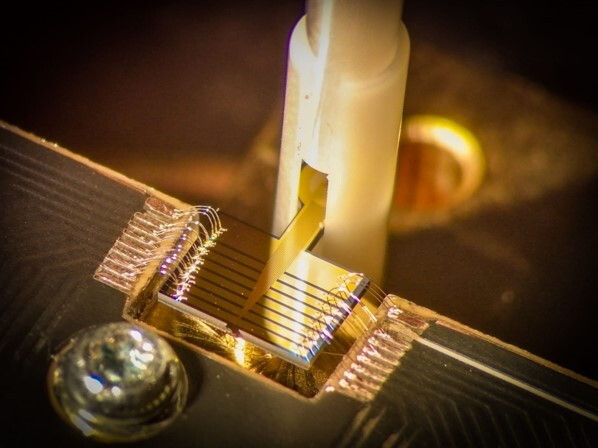Fast single-photon detectors and real-time key distillation enable high secret-key-rate quantum key distribution systems
F. Grünenfelder, A. Boaron, G. V. Resta, M. Perrenoud, D. Rusca, C. Barreiro, R. Houlmann, R. Sax, L. Stasi, S. El-Khoury, E. Hänggi, N. Bosshard, F. Bussières, H. Zbinden
Nat. Photon. 17, 422-426 (2023)
This work was a collaboration between the Quantum Technologies group at the University of Geneva, together with the company ID Quantique.
You can read the full article here.
The security of our data is of paramount importance. How can we be sure that data we are transmitting -- such as our banking details when making an online purchase -- cannot be accessed by outside parties with dishonest intentions?

A neat solution to this is quantum key distribution, or QKD, where the secrecy of the key depends only on the laws of quantum mechanics. Alice can encode quantum information (qubits) in particles of light (photons) and send them to Bob. Quantum mechanics tells us that any measurement on the qubit will affect the state of the system, and so if Eve is trying to listen in on the key being sent, Alice and Bob will see this and can abort their communication.
QKD has already been successfully implemented many times over the past decades, but a significant problem remains: to have real-world applicability, for example in video conferences, file downloads, etc, we need very large secret key rates (SKRs) -- that is, Alice needs to transmit photons at very high rates to Bob. SKRs have so far been limited by the speed of single-photon detectors. Some of the best single photon detectors are superconducting nanowire single photon detectors, or SNSPDs, which use superconducting materials to detect a single incident photon.
In a significant milestone to overcoming this limitation, our team, in collaboration with ID Quantique, developed a unique multipixel SNSPD where 14 independent pixels were placed in an interleaved geometry (shown in the photo on the bottom left). The 14 independent pixels mean this detector can count at very high speeds, 20 times higher than a single SNSPD, and has a high efficiency and low timing jitter.
The team then included this detector in their existing sophisticated QKD experiment, using a very-fast transmitter as Alice, working at 2.5GHz repetition rate. The photons from Alice travelled through 10km of fibre to Bob, where the state-of-the-art SNSPD was used to detect photons (schematic shown on the bottom right). From this, the team obtained a record high secret key rate of 64 Mbps, which is over 6 times higher than in previous works!
This work opens up new possibilities for ultra-secure communication and data transfer, which will be instrumental in our future quantum-era world.

Further information can also be found on the University of Geneva's website at this link, at ID Quantique here, and at Optics.org here.